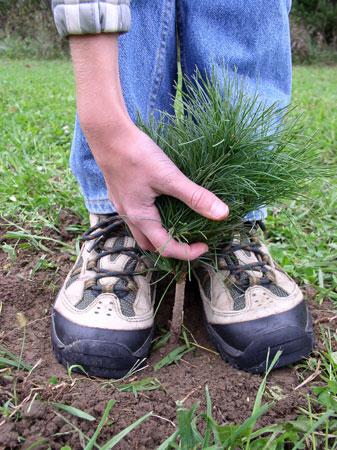There is more to planting trees than “one to a hole, green side up”.
I have planted a fair number of trees in the twenty some years I have been in this profession, and it is still a joy to put a tree in the ground with visions of more shade or veneer quality logs or maple syrup or fruit for birds dancing in my head. I have made my share of mistakes in these endeavors, whether it is planting the wrong tree for the site or planting them too shallow or too deep. The best advice I ever received regarding planting trees successfully was “one to a hole, green side up”. I would like to share a few more pieces of advice that will hopefully make your next tree planting a success.
A good starting point for any tree planting activity is to figure out which trees are best suited for your property and creating the optimal growing environment. That means choosing trees that will grow well in the kind of soil you have and the amount of shade you are growing them under. It also means eliminating any competition (i.e. other plants) your trees might have for water and soil nutrients.
As an undergraduate student, I worked a job where we planted trees to create a seed orchard. We planted hundreds of one year old plugs in an old field that didn’t want to give easily to the planting bar. Plugs are trees grown from seed in a container, and the “plug” of soil is planted along with the trees themselves. I thought speed was the important thing for this work, and was soon chastised for not planting them precisely. If the plug of soil isn’t completely buried under the soil, it can act like a wick and quickly dry out the tree’s root system. If the soil you are planting into is rocky, dry, or full of old plant roots, it is best to loosen up the soil as much as possible before planting your tree. That way the roots of your tree will more easily be able to expand outward without getting strangled by tightly packed soil. Some of the trees we planted those days did not make it, and my boss got his revenge as he chose a nice, rainy day for me and the rest of his crew to replace the dead ones.
More recently, I did some tree planting in an urban area for folks who received Habitat For Humanity homes. Now, you might think that planting larger trees in a yard would entail some very different techniques for success, but instead, some of the same principles still apply. Whether planting a small seedling or potted tree, it is important to dig a hole big enough for the tree’s roots. If you are planting trees that came in their own container (e.g. a pot or burlap), then you need to dig a hole large enough to fit the entire root ball or mass of soil and roots. If the trees you are planting are bare root stock, then you need a hole big enough for the roots to hang freely in. If the roots are bent or crowding each other, the tree may end up strangling itself as it looks for room to grow roots.
The next thing is to plant the tree at the right depth. You want to plant the trees so that the root collar is right at the soil line. This is the height at which a tree will naturally grow and planting above or below that line can have a big impact on the health and longevity of the tree. You can locate the root collar by finding the place on the stem where there is a slight swelling or change in color compared to the rest of the stem.
Finally, water is essential for the tree to successfully take root and grow where you plant it. For the tree planting at the Habitat homes, we had easy access to water and provided instructions to the homeowners to water the trees if there was no rainfall. When planting in the field on a large scale, you are almost entirely reliant on Mother Nature to provide the trees the water they need. With that in mind, the best time to plant trees tends to be in the spring, but I imagine you figured that out for yourselves.
Tree planting can be a fun and rewarding experience, especially if you pay attention to a few details that will increase your chances of success. There is a lot more that goes into a successful tree planting, and I will cover some of those topics in future articles.
